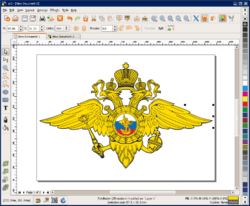SK1 (program)
 sK1 | |
| Developer(s) | sK1 Team |
|---|---|
| Stable release | 0.9.0 / 9 May 2009 |
| Preview release | 0.9.1 prerelease2 (codename "Made in Brazil") / 9 November 2010 |
| Written in | Python, C, Tcl/Tk |
| Operating system | Linux, FreeBSD |
| Type | Vector graphics editor |
| License | GNU Lesser General Public License |
| Website | sk1project.org |
| Developer(s) | sK1 Team |
|---|---|
| Stable release | 1.1.5[1] / June 26, 2010 |
| Operating system | MS Windows, Linux, FreeBSD |
| Type | Vector graphics translator |
| License | GNU Lesser General Public License |
| Website | sk1project.org |
sK1 is an open-source illustration program for the Linux platform that can be used as a substitute for professional proprietary software like CorelDRAW or Adobe Illustrator. Unique project features are CorelDRAW formats importers, tabbed multidocument interface, Cairo-based engine, and color management. The program was put on feature freeze since 2010, and development switched to its successor, PrintDesign.
History
A small team led by Igor Novikov started the project in 2003, based on the existing open source vector graphics editor Skencil. It was based on the Skencil 0.6.x series which used Tk widgets for a GUI. This version was dropped by the main Skencil developers who have since started developing a new branch of the program based on GTK+ (although this version remains immature compared to the 0.6.x series). sK1 has therefore become a fork. Although an attempt was made to unify the project with Skencil, it failed.
In 2007 the sK1 team reverse-engineered the CDR format.[2] The results and the first working snapshot of the CDR importer were presented at the Libre Graphics Meeting 2007 conference taking place in May 2007 in Montreal (Canada).[3] Later on the team parsed the structure of other Corel formats with the help of CDR Explorer.[4] As of 2008, the sK1 project claims to have the best import support for CorelDRAW file formats among open source software programs.
Target audience
Since the project was started by a small team of Ukrainian professionals in prepress, it was unambiguously focused on full support for PostScript, PDF, CMYK color model and color management at the expense of developing some advanced functions for illustrators[citation needed]. Informally the project is positioned as a free open source alternative to the commercial CorelDRAW[citation needed].
Functionality
- Tools
- Selection
- Node edit
- Magnifier glass
- Drawing of joint lines (polylines)
- Bézier curves drawing
- Ellipse drawing
- Polygon drawing
- Text editing
Supported formats
- Import
- CorelDRAW v7-X4 (CDR/CDT/CCX/CDRX/CMX)
- Adobe Illustrator up to version 9 (based on PostScript)
- Postscript (PS) and Encapsulated Postscript (EPS)
- Computer Graphics Metafile (CGM)
- Windows Metafile (WMF)
- XFIG
- Scalable Vector Graphics (SVG)
- Skencil/Sketch/sK1 (SK and SK1)
- Acorn Draw (AFF)
- PLT - HPGL cutting plotter files
- Export
- AI - Adobe Illustrator 5.0 (based on PostScript)
- PDF - Portable Document Format
- PS - PostScript
- SVG - Scalable Vector Graphics
- SK/SK1 - Skencil/Sketch/sK1
- CGM - Computer Graphics Metafile
- WMF - Windows Metafile
- PLT - HPGL cutting plotter files
Side (friendly) projects
- UniConvertor. It is an application for conversion of files from one vector format into another one. In fact it is a part of sK1, rewritten as a standalone code and being developed by the same team. UniConvertor is also used by Inkscape for opening CorelDRAW, WMF and Sketch/Skencil files.[5][6][7] Within a framework of Google Summer of Code 2008 the support of UniConvertor is being prepared for Scribus.
- CDR Explorer. It is a program that simplifies the reverse-engineering of Corel DRAW formats.
- pymfvu. It is a program for WMF/EMF files preview and export to SVG. At project development a comprehensive report on WMF support by various open source and closed applications was made. It is discontinued now.
- LinCutter. It is an application for interactive work with cutting plotters (PLT format).
Awards
- In 2007 the project was awarded the second place in the Trophées du Libre open source project contest in the "Multimedia and games" category.[8]
- In 2008 the project was awarded the third place in the contest Hackontest, organized by the Swiss Open Systems User Groupd /ch/open and sponsored by Google.
- In 2009 the project was awarded the second place in the contest "The best free project of Russia", conducted by Linux Format magazine. Among the group projects.
Versions
| Version | Date | Description |
|---|---|---|
| 0.9.0 | 9 May 2009 | First public release |
See also
- List of vector graphics editors
- Comparison of vector graphics editors
References
- ↑ "UniConvertor 1.1.5 release". Retrieved 2010-12-01.
- ↑ "sK1 illustration program - The history of sK1". Retrieved 2010-12-01.
- ↑ "Libre Graphics Meeting 2007 - Friday May 4". Retrieved 2010-12-01.
- ↑ "CDR explorer". Retrieved 2010-12-01.
- ↑ "Can I open/import *.cdr (Corel Draw Vector drawing file) files in Inkscape?". Retrieved 2010-12-01.
- ↑ "UniConvertor at Sourceforge.net". Retrieved 2010-12-01.
- ↑ "sK1 - UniConvertor - universal vector graphics translator". Retrieved 2010-12-01.
- ↑ "The 2007 edition winners". Les Trophées du Libre. Retrieved 2009-06-06.
External links
| |||||||||||